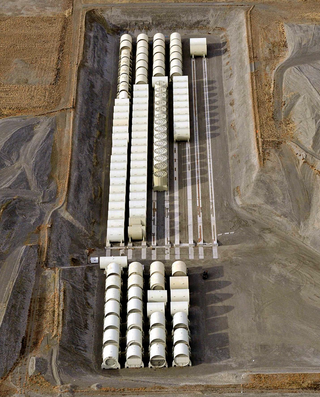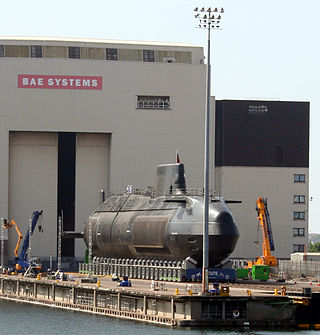The S7G reactor was a prototype naval reactor designed for the United States Navy to provide electricity generation and propulsion on warships. The S7G designation stands for:

United States naval reactors are nuclear reactors used by the United States Navy aboard certain ships to generate the steam used to produce power for propulsion, electric power, catapulting airplanes in aircraft carriers, and a few more minor uses. Such naval nuclear reactors have a complete power plant associated with them. All commissioned U.S. Navy submarines and supercarriers built since 1975 are nuclear powered, with the last conventional carrier, USS Kitty Hawk, being decommissioned in May 2009. The U.S. Navy also had nine nuclear-powered cruisers with such reactors, but they have since been decommissioned as well.
The S1G reactor is a naval reactor used by the United States Navy to provide electricity generation and propulsion on warships. The S1G designation stands for:
The S1C reactor was a prototype naval reactor designed for the United States Navy to provide electricity generation and propulsion on warships. The S1C designation stands for:

USS Nautilus (SSN-571) was the world's first operational nuclear-powered submarine and the first submarine to complete a submerged transit of the North Pole on 3 August 1958. Her initial commanding officer was Eugene "Dennis" Wilkinson, a widely respected naval officer who set the stage for many of the protocols of today's Nuclear Navy of the US, and who had a storied career during military service and afterwards.
The S3G reactor is a naval reactor used by the United States Navy to provide electricity generation and propulsion on warships. The S3G designation stands for:

The S5G reactor was a prototype naval reactor designed for the United States Navy to provide electricity generation and propulsion on submarines. The S5G designation stands for:
The A4W reactor is a naval reactor used by the United States Navy to propel warships and generate onboard electricity.

The seventh HMS Dreadnought was the United Kingdom's first nuclear-powered submarine, built by Vickers Armstrongs at Barrow-in-Furness. Launched by Queen Elizabeth II on Trafalgar Day 1960 and commissioned into service with the Royal Navy in April 1963, she continued in service until 1980. The submarine was powered by a S5W reactor, a design made available as a direct result of the 1958 US–UK Mutual Defence Agreement.
The Rolls-Royce pressurised water reactor (PWR) series has powered the Royal Navy's nuclear submarines since the Valiant class, commissioned in 1966.

A nuclear submarine is a submarine powered by a nuclear reactor, but not necessarily nuclear-armed. Nuclear submarines have considerable performance advantages over "conventional" submarines. Nuclear propulsion, being completely independent of air, frees the submarine from the need to surface frequently, as is necessary for conventional submarines. The large amount of power generated by a nuclear reactor allows nuclear submarines to operate at high speed for long periods, and the long interval between refuelings grants a range virtually unlimited, making the only limits on voyage times being imposed by such factors as the need to restock food or other consumables.
The S1W reactor was the first prototype naval reactor used by the United States Navy to prove that the technology could be used for electricity generation and propulsion on submarines.

Nuclear marine propulsion is propulsion of a ship or submarine with heat provided by a nuclear reactor. The power plant heats water to produce steam for a turbine used to turn the ship's propeller through a gearbox or through an electric generator and motor. Nuclear propulsion is used primarily within naval warships such as nuclear submarines and supercarriers. A small number of experimental civil nuclear ships have been built.
A nuclear navy, or nuclear-powered navy, refers to the portion of a navy consisting of naval ships powered by nuclear marine propulsion. The concept was revolutionary for naval warfare when first proposed. Prior to nuclear power, submarines were powered by diesel engines and could only submerge through the use of batteries. In order for these submarines to run their diesel engines and charge their batteries they would have to surface or snorkel. The use of nuclear power allowed these submarines to become true submersibles and unlike their conventional counterparts, they became limited only by crew endurance and supplies.

The light-water reactor (LWR) is a type of thermal-neutron reactor that uses normal water, as opposed to heavy water, as both its coolant and neutron moderator; furthermore a solid form of fissile elements is used as fuel. Thermal-neutron reactors are the most common type of nuclear reactor, and light-water reactors are the most common type of thermal-neutron reactor.
Air-independent propulsion (AIP), or air-independent power, is any marine propulsion technology that allows a non-nuclear submarine to operate without access to atmospheric oxygen. AIP can augment or replace the diesel-electric propulsion system of non-nuclear vessels.

Machinist's mate is a rating in the United States Navy's engineering community.
The S2W reactor was a naval reactor built by Westinghouse used by the United States Navy to provide electricity generation and propulsion on warships.

The S3W reactor is a naval reactor used by the United States Navy to provide electricity generation and propulsion on warships. The S3W designation stands for:








